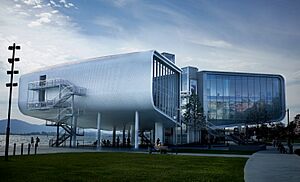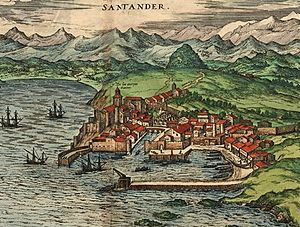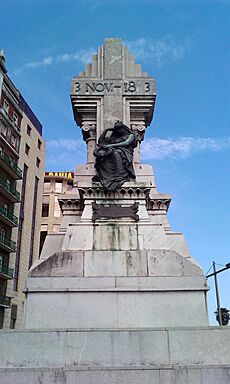Santander, Spain facts for kids
Quick facts for kids
Santander
|
|||
|---|---|---|---|
|
|
|||
|
|||
| Country | Spain | ||
| Autonomous community | Cantabria | ||
| Comarca | Bay of Santander | ||
| Judicial district | Santander | ||
| Founded | 26 BC, as Portus Victoriae Iuliobrigensium 9 January 1755, granting the title of city |
||
| Capital | Santander | ||
| Area | |||
| • Total | 36 km2 (14 sq mi) | ||
| Elevation | 15 m (49 ft) | ||
| Highest elevation | 108 m (354 ft) | ||
| Lowest elevation | 0 m (0 ft) | ||
| Population
(2018)
|
|||
| • Total | 172,044 | ||
| • Density | 4,780/km2 (12,380/sq mi) | ||
| Demonym(s) | Santanderine | ||
| GDP | |||
| • Metro | €12.839 billion (2020) | ||
| Time zone | UTC+1 (CET) | ||
| • Summer (DST) | UTC+2 (CEST) | ||
| Postal code |
39001-39012
|
||
| Official language(s) | Spanish | ||
Santander is the capital city of Cantabria, a region in Spain. About 172,000 people live there. It is a port city on the northern coast of Spain, right by the Cantabrian Sea.
People think Santander has been a port for a very long time because it has a great location. Records show it was a port as early as the 11th century. A big fire in 1941 destroyed much of the old city. Today, Santander is a popular place for tourists. It has an old town, beautiful beaches, and other fun attractions. The city's economy mainly relies on services like tourism. Its port is still very busy, with ferries going to the United Kingdom. Local food often includes fish and seafood. Santander is also home to the main office of a huge bank called Banco Santander. The city has a mild climate, meaning it's not too hot or too cold, but it often rains.
Contents
History of Santander
Early Settlements and the Middle Ages
It is hard to know exactly when people first settled in Santander. There are not many old writings or archaeological finds. But the north side of the bay was a good spot. It was safe from storms and had a hill for spotting attackers. This made it a perfect place for a town to grow.
Santander was first mentioned in a document in 1068. But even before that, in the 9th century, a king named Alfonso II built an abbey there. This abbey was called "Abbey of the Holy Bodies." It held important relics, which are special items from saints.
In 1187, another king, Alfonso VIII of Castile, gave the city a special charter. This document gave Santander certain rights and freedoms.
During the 12th and 13th centuries, the city had two main parts, or "pueblas." The older part, La Puebla, was on a hill. It had the old castle and the abbey. The newer part, Puebla Nueva, had convents and important streets. A bridge connected the two parts over a small river. This river flowed to the shipyards, where ships were built using wood from nearby forests. The city had to give one ship to the king each year.
By the end of the 1400s, Santander had about 4,000 to 5,000 people. The city grew because its harbor in the Bay of Santander was excellent. It was an important port for trade, especially with the New World. Santander officially became a city in 1755.
The Cabo Machichaco Explosions
On November 3, 1893, a steamship called the Cabo Machichaco caught fire. It was being unloaded at a pier in the city center. Many people watched as firefighters tried to put out the fire. But the ship was carrying about 40 tons of dynamite! The dynamite exploded, killing around 590 people and injuring about 2,000. The explosion also sank the ship and destroyed many buildings near the harbor.
A few months later, on March 21, 1894, a diver was trying to get cargo from the sunken ship. He accidentally set off about 11 more tons of dynamite. This second explosion killed 18 people and injured 11.
The Great Fire of 1941
Santander suffered a huge fire in 1941. A strong south wind made the fire spread quickly, and it burned for two days. The fire started near the harbor, the Cathedral, and the old medieval area. It destroyed the Old Town Hall and many other buildings.
The fire changed how Santander looked. The old small stone and wood buildings were replaced by large apartment blocks during the rebuilding. Only one person, a firefighter, died in the fire. But thousands of families lost their homes, and the city was in chaos. The fire destroyed most of the medieval town center and badly damaged the city's old Romanesque cathedral.
Geography
The city of Santander is located on the northern side of the Bay of Santander.
Climate
Santander has an oceanic climate. This means it has mild winters and cool summers. The average temperature changes by about 10°C (18°F) throughout the year. Winters are usually mild, with temperatures around 10°C (50°F). Very cold or very hot weather is rare.
The highest temperature ever recorded in downtown Santander was 40.2°C (104.4°F) in August 1940. The lowest was -3.8°C (25.2°F) in February.
Santander does not get as much sunshine as other parts of Spain, especially southern Spain. It gets about 1650 hours of sunshine per year. This is similar to cities like London or Paris. The areas closer to the coast get more sunshine but have cooler summer afternoons.
| Climate data for Santander, downtown, 64 m (1991–2020), extremes since 1877 | |||||||||||||
|---|---|---|---|---|---|---|---|---|---|---|---|---|---|
| Month | Jan | Feb | Mar | Apr | May | Jun | Jul | Aug | Sep | Oct | Nov | Dec | Year |
| Record high °C (°F) | 23.2 (73.8) |
26.6 (79.9) |
30.0 (86.0) |
33.4 (92.1) |
35.8 (96.4) |
37.4 (99.3) |
36.2 (97.2) |
40.2 (104.4) |
36.8 (98.2) |
32.4 (90.3) |
26.7 (80.1) |
23.8 (74.8) |
40.2 (104.4) |
| Mean daily maximum °C (°F) | 13.2 (55.8) |
13.3 (55.9) |
14.9 (58.8) |
15.8 (60.4) |
17.9 (64.2) |
20.3 (68.5) |
22.4 (72.3) |
23.3 (73.9) |
21.8 (71.2) |
19.8 (67.6) |
16.0 (60.8) |
13.8 (56.8) |
17.7 (63.9) |
| Daily mean °C (°F) | 10.7 (51.3) |
10.5 (50.9) |
11.9 (53.4) |
12.9 (55.2) |
15.1 (59.2) |
17.7 (63.9) |
19.8 (67.6) |
20.6 (69.1) |
18.9 (66.0) |
16.8 (62.2) |
13.4 (56.1) |
11.3 (52.3) |
15.0 (59.0) |
| Mean daily minimum °C (°F) | 8.1 (46.6) |
7.7 (45.9) |
9.0 (48.2) |
9.9 (49.8) |
12.3 (54.1) |
15.0 (59.0) |
17.1 (62.8) |
17.8 (64.0) |
16.0 (60.8) |
13.8 (56.8) |
10.7 (51.3) |
8.8 (47.8) |
12.2 (54.0) |
| Record low °C (°F) | −2.6 (27.3) |
−3.8 (25.2) |
−0.3 (31.5) |
1.6 (34.9) |
3.6 (38.5) |
7.5 (45.5) |
5.2 (41.4) |
11.4 (52.5) |
7.7 (45.9) |
4.4 (39.9) |
1.5 (34.7) |
−2.8 (27.0) |
−3.8 (25.2) |
| Average precipitation mm (inches) | 108.2 (4.26) |
74.3 (2.93) |
76.3 (3.00) |
86.4 (3.40) |
71.1 (2.80) |
61.9 (2.44) |
48.8 (1.92) |
60.0 (2.36) |
89.2 (3.51) |
115.1 (4.53) |
152.5 (6.00) |
130.3 (5.13) |
1,074.1 (42.28) |
| Average precipitation days (≥ 1 mm) | 12.8 | 10.1 | 9.7 | 11.6 | 10.4 | 8.7 | 8.3 | 8.5 | 9.3 | 11.2 | 14.7 | 13.1 | 128.4 |
| Mean monthly sunshine hours | 91 | 121 | 164 | 174 | 209 | 212 | 224 | 202 | 176 | 148 | 93 | 86 | 1,900 |
| Source 1: Météo Climat | |||||||||||||
| Source 2: Météo Climat (extremes) | |||||||||||||
| Climate data for Santander Airport (1981–2010) Record Temperatures (1954–2016) | |||||||||||||
|---|---|---|---|---|---|---|---|---|---|---|---|---|---|
| Month | Jan | Feb | Mar | Apr | May | Jun | Jul | Aug | Sep | Oct | Nov | Dec | Year |
| Record high °C (°F) | 25.1 (77.2) |
29.0 (84.2) |
31.3 (88.3) |
30.6 (87.1) |
36.8 (98.2) |
37.8 (100.0) |
37.2 (99.0) |
37.3 (99.1) |
37.6 (99.7) |
33.5 (92.3) |
28.0 (82.4) |
25.4 (77.7) |
37.8 (100.0) |
| Mean daily maximum °C (°F) | 13.6 (56.5) |
13.8 (56.8) |
15.7 (60.3) |
16.6 (61.9) |
19.1 (66.4) |
21.6 (70.9) |
23.6 (74.5) |
24.2 (75.6) |
22.8 (73.0) |
20.3 (68.5) |
16.3 (61.3) |
14.2 (57.6) |
18.5 (65.3) |
| Daily mean °C (°F) | 9.7 (49.5) |
9.8 (49.6) |
11.3 (52.3) |
12.4 (54.3) |
15.1 (59.2) |
17.8 (64.0) |
19.8 (67.6) |
20.3 (68.5) |
18.6 (65.5) |
16.1 (61.0) |
12.5 (54.5) |
10.5 (50.9) |
14.5 (58.1) |
| Mean daily minimum °C (°F) | 5.8 (42.4) |
5.7 (42.3) |
7.0 (44.6) |
8.3 (46.9) |
11.1 (52.0) |
13.9 (57.0) |
16.0 (60.8) |
16.4 (61.5) |
14.4 (57.9) |
11.8 (53.2) |
8.7 (47.7) |
6.7 (44.1) |
10.5 (50.9) |
| Record low °C (°F) | −5.4 (22.3) |
−5.2 (22.6) |
−3.0 (26.6) |
0.6 (33.1) |
2.6 (36.7) |
5.6 (42.1) |
6.0 (42.8) |
6.0 (42.8) |
2.8 (37.0) |
1.4 (34.5) |
−3.5 (25.7) |
−5.2 (22.6) |
−5.4 (22.3) |
| Average precipitation mm (inches) | 106 (4.2) |
92 (3.6) |
88 (3.5) |
102 (4.0) |
78 (3.1) |
58 (2.3) |
52 (2.0) |
73 (2.9) |
83 (3.3) |
120 (4.7) |
157 (6.2) |
118 (4.6) |
1,129 (44.4) |
| Average precipitation days (≥ 1 mm) | 12 | 11 | 10 | 12 | 10 | 8 | 7 | 8 | 9 | 11 | 13 | 12 | 124 |
| Average relative humidity (%) | 72 | 72 | 71 | 72 | 74 | 75 | 75 | 76 | 76 | 75 | 75 | 73 | 74 |
| Mean monthly sunshine hours | 85 | 104 | 135 | 149 | 172 | 178 | 187 | 180 | 160 | 129 | 93 | 74 | 1,649 |
| Source: Agencia Estatal de Meteorología | |||||||||||||
Fun Things to See and Do in Santander
The old town has many bars and restaurants that are popular with visitors. The El Sardinero beach, a few kilometers away, is also a favorite spot.
- Santander Cathedral: The oldest part of the cathedral, called "cripta del Cristo," was built around the year 1200. It stands on top of even older Roman buildings. It is 31 meters (102 feet) long and 18 meters (59 feet) wide. Its style mixes Romanesque and Gothic designs.
- Lighthouse of Cabo Mayor: This lighthouse stands at the entrance to the Bay of Santander.
- Parque de la Vaguada de las Llamas: This is one of the biggest parks in northern Spain. It covers 11 hectares (27 acres) of the city.
- Smart City: Santander is a "smart city." This means it uses technology to make things better for people. It has 12,000 sensors around the city!
Economy
Santander is a key service center for its region. It has many important public and private organizations. These include the Marqués de Valdecilla University Hospital and the University of Cantabria. The huge international bank, Banco Santander, also has its main office here.
Tourism is a very important part of Santander's economy. The city wants to attract more visitors, not just in summer. They host conventions, conferences, cultural festivals, and welcome cruise ships.
Transportation
You can take a ferry from Santander to Portsmouth and Plymouth in the United Kingdom. There are also ferries to Cork in Ireland. All these ferries are run by Brittany Ferries. The Santander railway station serves three million passengers every year.
The city also has an airport, the Seve Ballesteros–Santander Airport (SDR). It is located 4 kilometers (2.5 miles) south of the city center.
Education

Santander has several important educational institutions:
- University of Cantabria: This is the largest university in the Cantabria region.
- European University of the Atlantic: A private university that opened in 2013.
- Universidad Internacional Menéndez Pelayo (UIMP): This university specializes in teaching Spanish language and culture to students from other countries.
- Central Library of Cantabria: This library was founded in 1839.
Culture
Santander has a rich cultural life with many events. The UIMP is a big international summer university. It also organizes large festivals of music and dance. Some of the main cultural events include the Festival Internacional de Santander (FIS) and the Paloma O'Shea International Piano Competition.
Local Food
Santander's cuisine (food) is typical of Cantabria. It mostly uses seafood. Popular shellfish include almejas (clams) and navajas (razor clams). You can also find fish like seabream, red mullet, anchovies, seabass, and sardines. Squid and cuttlefish are also commonly eaten.
Some special dishes from Santander are:
- Rabas: These are fried calamari (squid).
- Cocido montañés': A bean stew.
- Seafood dishes: These range from seabass and sardine to other products like morguera.
Sports
Racing de Santander is the city's main football (soccer) team. They play their home games at the Campos de Sport de El Sardinero.
Here are some of Santander's top sports teams:
| Club | Sport | League | Stadium |
|---|---|---|---|
| Racing de Santander | Football | Segunda División | Campos de Sport de El Sardinero |
| GoFit Sinfín | Handball | Liga ASOBAL | Pabellón Municipal de La Albericia |
| Cantbasket and CD Estela | Basketball | Liga EBA | Palacio de Deportes de Santander |
| Balonmano Pereda | Women's handball | División de Honor B | Pabellón de Numancia |
| Real Sociedad de Tenis de La Magdalena | Field hockey | Honour Division | La Albericia |
| Señor Independiente | Rugby Union | Honour Division | Mies de Cozada |
Images for kids
-
Building of Bank of Santander
See also
 In Spanish: Santander (España) para niños
In Spanish: Santander (España) para niños


























